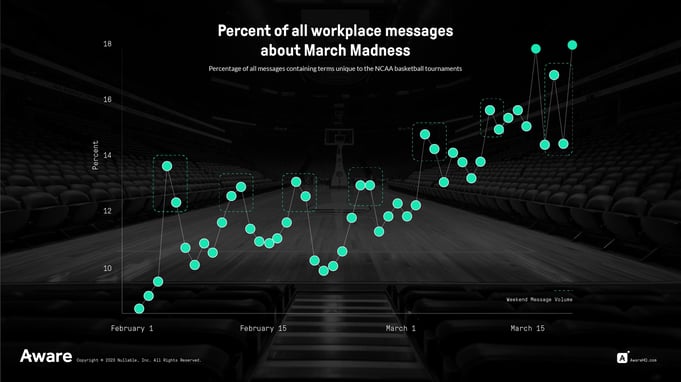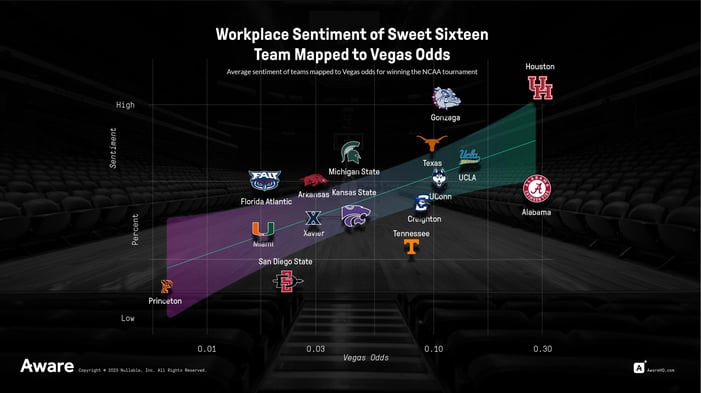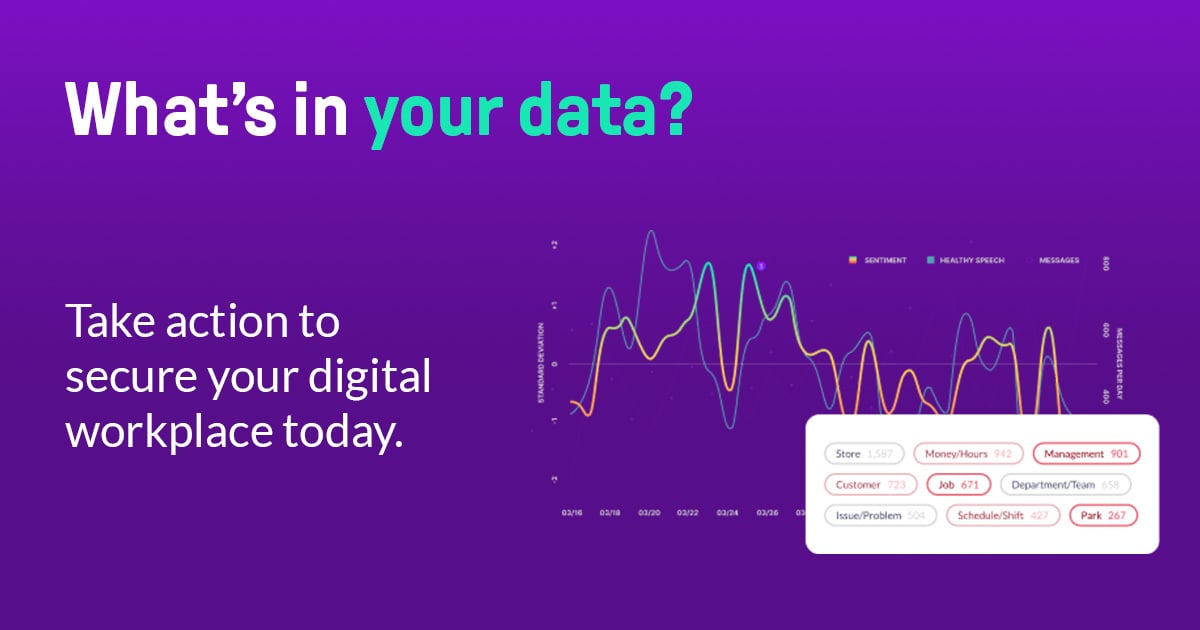March Madness — The People’s Pick of the Sweet 16
by Aware
In a tournament already rife with upsets, two No. 1 seeds out of the game and underdogs barking, who are the great American public rooting for to cut down the nets?
Aware has a unique ability to answer that question. Our collaboration intelligence platform’s powerful and accurate natural language processing (NLP) models understand the context of conversations happening every day in workplace tools like Slack, Teams, and Zoom.
Although primarily used for work, these tools are the new office water cooler. Their inherently social nature encourages casual conversations. March Madness provides a perfect opportunity to explore how modern, distributed teams maintain social ties, and how insightful collective intelligence can be.
Aware’s rockstar data scientists got to work exploring the sentiment surrounding each of the NCAA Sweet 16 within anonymized collaboration conversations from our data-sharing customers. They analyzed over 400 million messages and charted workplace sentiment against Vegas odds to see if there was a correlation. Does the voice of the employee match the oddsmaker? Can collective intelligence hold real insight?
What they found might surprise you.
March Madness begins in early February
The first thing we discovered was that conversations about March Madness began well before March. An estimated two-thirds of employees will fill their own NCAA brackets, so it isn’t surprising to see early signs of office pool organization far in advance of Selection Sunday.
QuickBooks calculated that just under half of employees spent work time participating in March Madness activities — about 25 minutes per day during the tournament. However, 72% of managers felt the tournament had a positive impact on employee morale and engagement.

Engagement spikes on weekends
Our data shows that business leaders should be less concerned about loss of productivity than they think, as engagement leading up to the tournament was highest on the weekends and lowest midweek.
This indicates something remarkable — employees are using collaboration tools to talk about popular current events with their coworkers on their days off. These conversations aren’t just small talk to pass the time with people employees are forced to be around, they’re evidence of strong company culture and good interpersonal relationships between team members.
Without the simplicity and convenience of collaboration tools like Slack, Teams, or Workplace from Meta, what are the chances your employees would contact each other out of hours for anything? By introducing these tools, employers create an environment where their people feel comfortable reaching out to one another.
There’s a strong correlation between sentiment and odds
But now for the real surprise — there is a clear link between the bookmaker’s odds and social sentiment. That suggests something incredible: insights at scale can be as accurate as the projections of professional oddsmakers.

Houston and Princeton are our sentimental outliers, and they’re also the most and least likely to win the tourney at this stage. We calculate the correlation coefficient between sentiment and odds at 0.59 on a -1:1 scale — that’s enough to get data scientists very excited.
“If I saw this in social/behavioral science data — knowing what I know about how messy that data is — I would check and recheck my numbers,” says Aware VP of Behavioral Intelligence Dr. Jason Morgan.
Even removing the outliers still produces a strong correlation between sentiment and the tournament odds. But the favorite being, well, the favorite is hardly surprising. And neither is the underdog being bottom of the pack — especially when they’re an Ivy League school. So, odds aside, who are the people really championing? Which teams are breaking the mold?
Our data shows several clear outliers. Florida Atlantic and Gonzaga sentiment trends much higher than their relative odds, and Alabama sentiment appears significantly lower. The Crimson Tide might have entered the tourney as a No. 1 seed, but they’ve yet to win American hearts and minds. If the people have their say, it’ll be the Owls or Bulldogs who cut down the nets.
Why does this matter?
Collaboration tools took hold during the pandemic and are now a critical part of your employees’ digital experience — even beyond regular working hours. The informal conversations they encourage blur the line between business and social relationships, helping build a strong, cohesive company culture.
During work and beyond, your people are talking. They don’t work in a vacuum. The correlation between the odds and the favorites in the March Madness tournament is no accident. In fact, it’s a statistical improbability. But the data clearly shows that there is a strong connection between what’s happening in the wider world and how it makes your employees feel.
Your collaboration tools contain all their knowledge, wisdom, and insights. At scale, those insights can do remarkable things, from predicting the odds during March Madness to unleashing new innovations for your business. Aware brings context to employee voices and transforms the way businesses operate with real-time data that accelerates growth, reveals new opportunities, and protects the bottom line.
Your organization is human and it’s sending you signals. How do you listen and respond?









